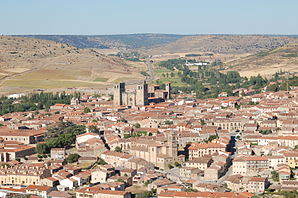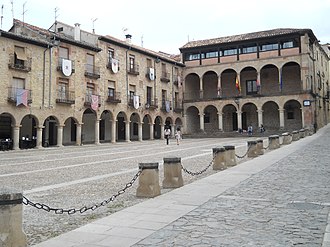Sigüenza
| Sigüenza municipality | ||
|---|---|---|
 Sigüenza - city view
|
||
| coat of arms | Map of Spain | |

|
|
|
| Basic data | ||
| Autonomous Community : |
|
|
| Province : | Guadalajara | |
| Comarca : | La Serranía | |
| Coordinates | 41 ° 4 ′ N , 2 ° 38 ′ W | |
| Height : | 1000 msnm | |
| Area : | 386.87 km² | |
| Residents : | 4,309 (Jan 1, 2019) | |
| Population density : | 11.14 inhabitants / km² | |
| Postal code : | 19250 | |
| Municipality number ( INE ): | 19257 | |
| administration | ||
| Website : | Sigüenza | |
Sigüenza is a small town in central Spain and a municipality with 4,309 inhabitants (as of January 1, 2019) in the north of the province of Guadalajara in the autonomous community of Castile-La Mancha . The city has been classified as a cultural asset ( Bien de Interés Cultural ) in the conjunto histórico-artístico category since 1965 ; It is located on a trade and pilgrimage route ( Ruta de la Lana ) that was already used in the Middle Ages and on the Camino del Cid, which was only developed in the 20th century for tourist reasons .
Location and climate
Sigüenza is located on the southwest side of the Iberian Mountains on the upper reaches of the Río Henares at an altitude of about 1000 m . The provincial capital Guadalajara is just under 74 km (driving distance) to the southwest. The climate is temperate to warm; Rain (approx. 475 mm / year) falls - with the exception of the summer months - over the year.
Population development
| year | 1857 | 1900 | 1950 | 2000 | 2019 |
| Residents | 4,192 | 4,638 | 4,615 | 4,594 | 4,309 |
Due to immigration from the surrounding villages and the incorporation of several smaller communities in the 1960s and 1970s, the population of the small town has remained more or less constant.
economy
For centuries, Sigüenza was the artisanal, mercantile and cultural center of a large number of villages (aldeas) and hamlets (pedanías) in the area, the inhabitants of which mostly lived as self-sufficient farmers, whereby agriculture and cattle breeding were equally important. Crafts of the most varied kinds developed in the city itself ; There were several salt pans in their vicinity .
history
Due to its strategically favorable location, the area around Sigüenza was already populated in the Paleolithic and Neolithic . Pliny the Elder mentions Segontia in the 1st century AD in his work Naturalis historia as an important Celtiberian settlement that was in the tribal area of the Arevacians , which was captured by the Romans in the Numantine War (154-133 BC). After the end of the Western Roman Empire , the city was conquered by the Visigoths , who also founded the diocese of Sigüenza in 589. Taken by the Moors around 712 , the Christians, under the leadership of Bishop Bernahard of Agen, recaptured the city in 1123 (or 1124) ( reconquista ) . Despite the city's location in the south of the Christian sphere of influence, construction of the cathedral began only a little later, but its completion would take several centuries. The most important person in the city's history was Bishop Pedro González de Mendoza (1428–1495) from the House of Mendoza , who was promoted to Bishop of Sigüenza on October 30, 1467 - an office that he - despite numerous other functions at the court of the Catholic Kings - up to held at his death.
From August to October 1936, one of the many bloody battles of the Spanish Civil War raged near Sigüenza .
Attractions
Sigüenza has a large number of historically or culturally significant sights; the most important are:
- Santa María de Sigüenza Cathedral , 12th to 14th centuries
- Castillo de Sigüenza , originally from the 12th century, destroyed in the civil war, rebuilt in the 1970s (now used as a Parador )
- Casa del Doncel , Gothic house from the 13th century
- Castillo de Pelegrina , castle from the 12th century
- Castillo de Riba de Santiuste , castle from the 12th / 13th centuries century
- Nuestra Señora de los Huertos Monastery , built in the 16th century
- Romanesque church of San Salvador in the district of Carabias
See also
sons and daughters of the town
- Rodrigo Alemán (1470–1542), Spanish sculptor
- Juan José Asenjo Pelegrina (* 1945), Archbishop of Seville
Web links
- Sigüenza, history - photos + brief information (Spanish)
- Sigüenza, history - information (spanish)
Individual evidence
- ↑ Cifras oficiales de población resultantes de la revisión del Padrón municipal a 1 de enero . Population statistics from the Instituto Nacional de Estadística (population update).
- ↑ Sigüenza - climate tables
- ^ Sigüenza - population development
- ↑ Sigüenza - History
- ^ Sigüenza - history and sights



